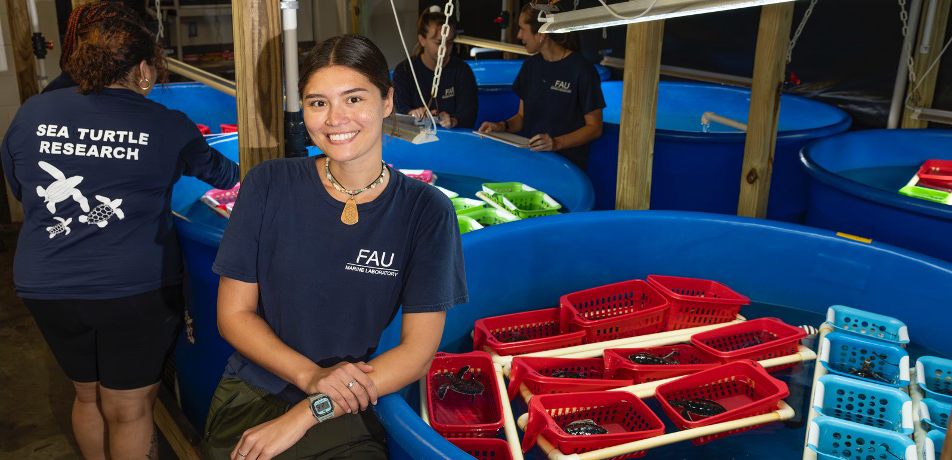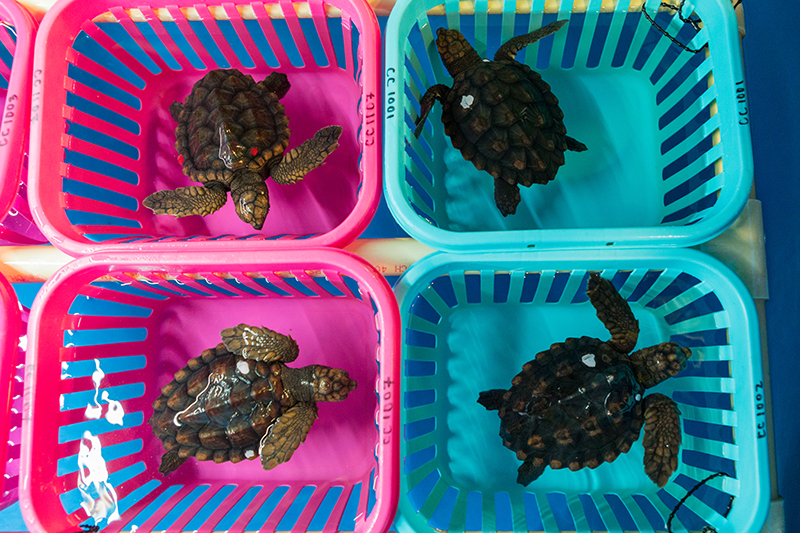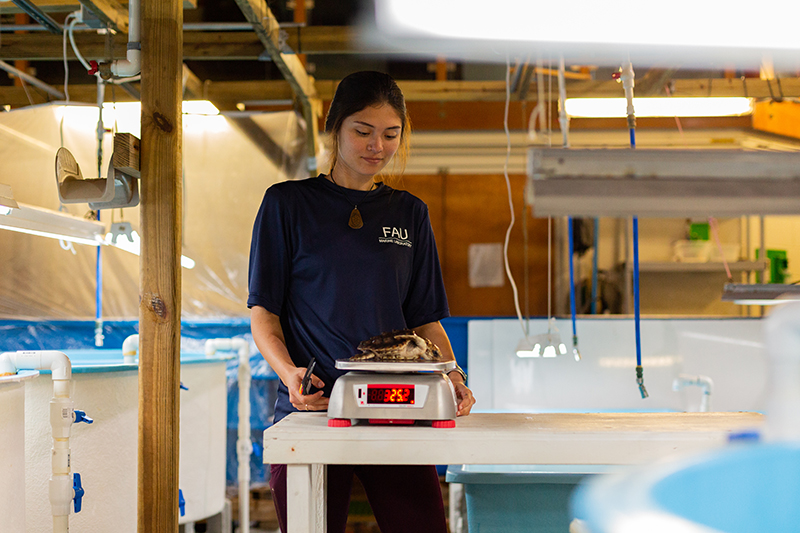
Author: Emily Turla; edited by Gael-Lynn Laguerre
Date: March 20, 2024
The relationship between the National Save the Sea Turtle Foundation (NSTSTF) and the Florida Atlantic University (FAU) Marine Laboratory at the Gumbo Limbo Environmental Complex has remained strong since the lab’s renovation and rededication in 2014. The NSTSTF is committed to enhancing the facility and assisting FAU professors and students in furthering groundbreaking sea turtle research and important aspects of marine science to share with the public!
The foundation also sponsors and publishes the Florida Environmental Outreach Magazine, which highlights current research, environmental news, and other happenings in the marine world. In the most recent issue, the magazine collaborated with FAU Marine Laboratory Coordinator and Ph.D. Candidate in FAU’s Department of Biological Sciences, Emily Turla. In her featured article, A Year in the life of a Marine Laboratory Coordinator, Turla describes her many “day in the life” marine lab duties. Readers get a well-rounded glimpse into her daily responsibilities and how they change over the course of the nesting season. Below are some excerpts from Emily’s article that describe her busy, yet fascinating, days as a Lab Coordinator!
When thinking of how to write this “day in the life” article, it was difficult to develop a typical description since the daily tasks can vary greatly. Working with wildlife, specifically marine turtles, always makes for unpredictability. I’ve divided a description of a typical day into the different parts of the year, since that more accurately reflects what I may be found doing at any given time.
There are a lot of moving parts in a research laboratory that, annually, rears about 300 hatchling turtles of the three species (loggerheads, green turtles, and leatherbacks) nesting locally. We raise the turtles for several months to a size enabling us to determine their sex. Those animals must be closely monitored, fed the correct diet for each species, cleaned, weighed, and measured as they grow.
These are the busiest months of the year at the Marine Lab. During these times, a day typically consists of checking in new hatchlings, collecting and entering data, coordinating hatchling releases, ensuring all the turtles in the lab are properly cared for, and supervising the undergraduate student help. One of our projects involves determining what happens to the juvenile turtles we release, specifically where their oceanic “nursery areas” are located. To find out, we attach satellite tags to each animal, but developing appropriate methods to secure the tags on a growing turtle has not been easy!

By this time, we have released many of our turtles, but typically, we still have a decent number remaining in our tanks. Students get more “into the groove” of their responsibilities; their duties are more predictable, so I can let them handle the routine day-to-day tasks. I also start analyzing the data we’ve accumulated and produce new ideas that form the basis for the research proposals that we submit in time for their review and approval before the next nesting season. Reports to various permitting and funding agencies are due at the end of the year. I accumulate the information required to get them written.

This period focuses on data analysis, writing manuscripts and progress reports, and preparing materials for research talks and conferences. I spend more time on the computer than anything else since there is a lot that needs to be accomplished before the next season. These months finally provide some time for catching up!
In April we have usually released all the turtles collected during the previous nesting season, and we begin monitoring the nesting activities of the turtles that will furnish a new batch of hatchlings in the coming summer. Hatchlings typically begin emerging from those nests in late May, so we are busy with preparations for the next batch of turtles. Workdays during this time include inventorying our equipment, setting up data collection sheets, and lots of lab maintenance. This time of year involves lots of planning, prepping, and anticipation!
Being involved in all the projects supported by the FAU Marine Laboratory is a truly unique experience! I have gained tremendous insight, as well as appreciation, for what is involved in the administration of a multi-purpose research program, one designed to better protect and manage several species of imperiled marine turtles, train and manage enthusiastic undergraduate students to effectively assist in these efforts, and learn more about the biology of these magnificent animals. At times it can be a lot to manage, but to-do lists, calendars, spreadsheets, and open lines of communication help a lot! Now, it’s time to prepare for the next season and do it all over again!
